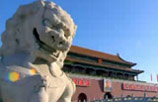Japan, China may compete for California rail project
Updated: 2015-04-28 15:30
By PAUL WELITZKIN in New York(China Daily USA)
|
|||||||||||
Japanese Prime Minister Shinzo Abe is expected to promote his country's high-speed train industry when he visits California and the US this week, setting up a competition with manufacturers in China and other countries.
The global high-speed rail industry is eager to earn a piece of California's planned $68 billion high-speed railway project. By 2029, the rail system will run from San Francisco to Los Angeles, making the trip between the cities in under three hours, and will eventually extend to Sacramento and San Diego, totaling 800 miles with up to 24 stations.
China CNR Corp, its unit Tangshan Railway and US-based SunGroup USA are among those who have submitted an expression of interest in supplying 95 trains for the project, according to previous news reports.
Noting that almost all of the current technology and expertise in high-speed rail belongs to overseas companies, Rod Diridon, Sr., emeritus executive director of the Mineta Transportation Institute in San Jose, California, and a former member of the California High-Speed Rail Authority, said California and other potential US high-speed sites have no choice but to look to foreign suppliers.
"American transportation has fallen behind the rest of the world so it will be necessary to have a private-public partnership to construct a system like the one in California," he told China Daily on Monday.
Diridon, who has been involved with high-speed rail for over 30 years, said "…many of us have been begging Congress to invest in our system. We've been living off the investments made in our transportation system that were made in the middle of the 20th century," he added.
Because California will accept $3.4 billion in federal funding for the project, Diridon said there is a buy-American component the state will have to comply with. "There will probably have to be a manufacturing facility in the US, preferably in California, to provide at least some of the components."
Diridon acknowledged that bidders for the $68 billion California project may get an advantage if they can come up with all or part of the financing for the state. "We don't know the final bid specifications yet," he said. "But it's obvious that a public-private partnership would be beneficial to California."
Right now, Diridon said California has begun work on the Merced-Fresno section at a cost of $2.5 billion. Later bids will be awarded on the Fresno-Visalia and Visalia-Bakersfield sections totaling $6 billion.
"It can't be stopped. The (California) Supreme Court has said it won't hear any more appeals," Diridon said.
In addition to California, other potential US sites for high-speed rail include Texas, the Northeast and a proposed Chicago to St. Louis service. "There is a saying that California leads and the rest of the nation follows," said Diridon. "That might be the case here. I don't think the other states will allow California to get too far ahead."
Abe will promote his country's Shinkansen bullet-train technology during his visit to the US. He may also focus on the magnetic levitation bullet train being developed by Central Japan Railway Co. The train reached a record speed of 603 kilometers (374 miles per hour) an hour in a test run recently.
In October, Abe said he had proposed to President Barack Obama to roll out the levitation bullet train in the Northeastern US as a symbol of bilateral cooperation. Abe said then that a passenger could travel on the train from Washington to New York in less than an hour.Amtrak's Acela train takes 2 hours 45 minutes to go that distance. In March, the US House of Representatives passed a bill that calls for a study of high-speed rail service on the 450-mile Northeast Corridor between Boston and New York.
China may be a latecomer in high-speed train construction, but some of its technologies are considered among the best in the world. For example, one requirement is that the surface of the rails that touches the wheels must be clean and the track geometry needs to be smooth because even the tiniest flaw could shake a train traveling at high speeds. The rails on the Beijing-Shanghai high-speed train line are so smooth that the test train reached speeds of 380 kilometers an hour without any evident shaking.
In addition to China and Japan, companies in Europe and Canada may also compete for the California project.
paulwelitzkin@chinadailyusa.com
Today's Top News
Nepalis wait for quake help as death toll passes 4,000
61 suspects back home to be tried
PLA's Moscow debut confirmed
DPRK, Russia ink protocol after inter-governmental meeting
Belt and Road Initiative a boost to China, regional economy
China rescue team starts work in Nepal
At least 20 dead in Tibet following Nepal quake
Opinion: China leads in many high-speed rail aspects
Hot Topics
Lunar probe , China growth forecasts, Emission rules get tougher, China seen through 'colored lens', International board,
Editor's Picks

|

|

|

|

|

|






